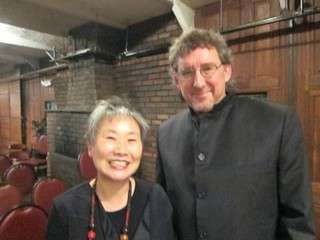|
Back
Cage and Company New York
Barge Music, Old Fulton Street, Brooklyn
09/14/2012 -
Here and Now Series: Homage to John Cage
John Cage: Two Pieces for Piano (1946) – Solo for Piano (1957) (from Concert for Piano and Orchestra) – One (1987) – Swinging (1989) – Dream (1948)
Frederic Rzewski: Winnsboro Cotton Mill Blues
Morton Feldman: Palais de Mari
Hyo-shin Na: Near and Dear (World Premiere)
Thomas Schultz (Pianist)

H.-s. Na, T. Schultz (© Coco T. Dawg)
Thomas Schultz is one of those rare pianists who offers composers of the 20th and 21st centuries, transformng the most eccentric or aberrant notes into shimmering gemstones. Because of his repertoire, he probably doesn't have Standing Room Only audiences, but that is probably fine with him, for he gives his limited devoted an unlimited look into a specialized world
Not only does Mr. Schultz perform the great composers of our day, but he has worked closely with the likes of John Cage, Morton Feldman, Earle Brown and Elliott Carter. Several eminences, including Christian Wolff and Frederic Rzewski, have written pieces for him. And after hearing his recital at BargeMusic last night, it was obvious why.
Aside from his technical facility, Mr. Schultz possesses an almost unerring sensitivity for his composers. He can take a "short" work like the 25-minute Feldman Palais de Mari, and give each phrase such concern, each phrase such personality, that the oftimes static composer gains an organic shape.
Mr. Schultz might not be so convincing in John Cage's One, but I doubt if any pianist could make this "stopandgo-and-stop and pause, pause, pause andgoagain" piece come alive, But the other Cage pieces he played last night not only had an immediate attraction, but Mr. Schultz underlined the differences in Cage's different eras.
The program was called "Homage to John Cage" but Mr. Schultz arranged the recital with four different composers, all of whom were connected in one way or another.
Cage and Feldman, both of them reveling in the sounds of individual notes, could have worked as "musicalizers" of two different arts. Cage was obsessed with the dance, and while none of his pieces last night were especially balletic, they did, under Mr. Schultz's fingers, actually step and (in Swinging) give a tenuous jump. The very early Dream could have been written for Ballet Russes by Poulenc. His 1946 pieces, which opened the recital did leap from phrase to phrase. One never thought of Cage being a Rap artist, but those coy little raps on the piano itself were, well, interesting.
What Cage was to dance, Feldman felt himself to be for painting. Thus his Palais de Mari was heard as an abstract tapestry. A few brush-daubs here, a dissonance of primary colors at the top, a blot, a splotch, a truncated lyrical line there, Mr. Schultz never punctuated the music, but let the coloristic nuances and changes speak for themselves.
Two other composers were the opposite of Cage and Feldman, filling up the keyboard with songs, phrases, massive virtuosity and (yes) enigmas. And while not obvious, Frederic Rzewski and Hyo-shin Na did have an important element in common.
One didn't quite connect the super-American grand, jazzy, tumultuous, onomatopoetically omnivorous Winnsboro Cotton Mill Blues with the more finespun Near and Dear by the Korean composer Hyo-shin Na. But both composers had used, within their fine tapestries, songs of their countries.
The blatantly politically progressive Mr. Rzewski started with the sounds of North Carolina cotton mill machinery, grinding and farting, and the protest song rising above the inhuman noises It's a mammoth piano epic, the kind which, had Charles Ives been politically inclined, would have written himself. Mr. Schultz played it with a dynamism that was the opposite of Cage. Instead of a few raps on the piano, the pianist used fingers, hands, arms and elbows to make his dynamic points.
Hyo-shin Na had three playful pieces in her Near and Dear, finished only a few weeks ago. But in each of these extended connected bagatelles, she hid (like animals hidden in a child's page of a jungle) music which sounded Korean, or, in the second piece, those emblamatic barcarolle rhythms. It was digitally difficult, Mr. Schultz ran through it with joy, and Hyo-shin Na, in the audience for this premiere, was obviously as we all were delighted with Mr. Schultz.
Harry Rolnick
|